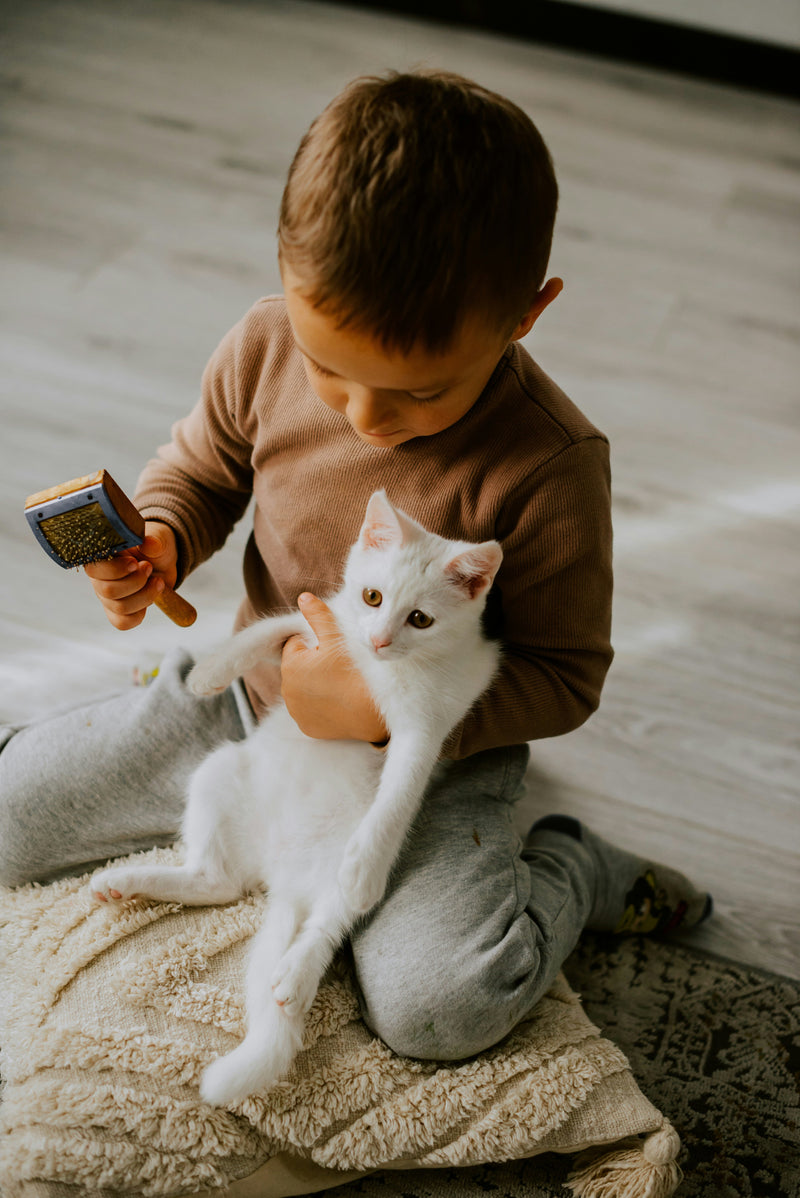
The Power of Paws: How Animals Shape Little Hearts and Growing Minds 🐾❤️
A shy five-year-old who barely speaks above a whisper suddenly lights up when a gentle golden retriever approaches. She carefully extends her hand, whispers secrets into fluffy ears, and for the first time in months, her parents hear genuine laughter echoing through the house. This magical moment isn't just heartwarming—it's scientifically profound. The bond between children and animals creates ripple effects that touch every aspect of a child's development, from emotional intelligence to academic achievement to future relationships. 🌟👧🏽
Beyond Cute and Cuddly: The Science of Animal-Child Connections 🧠🔬
The relationship between children and animals isn't just about adorable Instagram moments (though those certainly don't hurt!). Researchers have discovered that interactions with animals trigger remarkable changes in children's developing brains and hearts:
- Oxytocin levels surge when children pet or play with animals, reducing stress and promoting feelings of safety 🧬💕
- Mirror neuron activity increases, enhancing empathy and social understanding 🪞🧠
- Cortisol levels decrease, creating calmer, more regulated emotional states 😌🌊
- Serotonin production boosts, supporting mood stability and happiness 🌈😊
- Neural pathways associated with caregiving and responsibility strengthen 🛤️💪
The My Furry Soulmates series captures these profound connections through engaging stories that help children understand and appreciate the special bonds they share with animal companions. 📚🦊
The Emotional Intelligence Classroom: What Animals Teach That Textbooks Can't 🎓❤️
Animals serve as some of the most patient and effective teachers of emotional intelligence. Unlike human interactions, which can feel complex and overwhelming for young minds, animals offer pure, unconditional responses that help children develop crucial emotional skills:
Reading Non-Verbal Cues 👀🐕
Animals communicate primarily through body language, facial expressions, and energy. Children who regularly interact with pets become incredibly skilled at:
- Recognizing subtle emotional signals 🔍
- Adjusting their own behavior based on others' needs 🔄
- Developing intuitive understanding of comfort and boundaries 🛡️
Practicing Emotional Regulation 🧘♀️🐱
When a child feels overwhelmed, many instinctively seek comfort from their pet. This natural tendency teaches them:
- Self-soothing strategies that don't rely on adult intervention 🤗
- How to find calm in the midst of emotional storms ⛈️➡️☀️
- The healing power of quiet presence and physical comfort 🕯️
Learning Unconditional Love 💝🐾
Perhaps most powerfully, animals offer children their first experience of love without conditions. A dog doesn't care if you had a bad day at school, failed a test, or got in trouble. This experience teaches children:
- Self-worth that isn't tied to performance 🌟
- The possibility of love that doesn't fluctuate based on behavior 💫
- How to offer and receive affection freely 🎁
The Kindness Mindset Journal helps children reflect on and deepen these lessons of compassion and emotional awareness. 📔💚
The Responsibility Revolution: Growing Character Through Care 🌱👦🏿
Caring for an animal—whether it's a family pet, classroom guinea pig, or visiting therapy dog—creates unique opportunities for character development that are difficult to replicate in other settings:
Daily Commitment Building 📅💪
Unlike chores that benefit the family, caring for animals creates responsibility that directly impacts another living being. Children learn:
- The importance of consistency in meeting others' needs 🔄
- How their actions (or inactions) affect vulnerable creatures 🐹
- The satisfaction that comes from being truly needed 🌟
Empathy in Action 💝🎯
When a pet is sick, scared, or uncomfortable, children naturally want to help. This desire translates into:
- Practical experience putting others' needs before their own wants 🎯
- Understanding that love sometimes means doing things we don't feel like doing 💪
- Learning that caring for others is both a privilege and a responsibility 👑
Consequence Learning Without Punishment ⚖️📚
Animals provide immediate, natural feedback about care quality. A neglected fish tank becomes cloudy, an unfed cat meows insistently, a stressed hamster becomes withdrawn. Children learn about consequences in a context that feels natural rather than punitive.
The Confident Mindset Journal helps children process and take pride in their growing capabilities as caregivers and responsible family members. 📝✨
The Social Skills Laboratory: How Animals Teach Human Connection 👫🐕🦺
Interestingly, children who have positive relationships with animals often develop stronger human social skills. Animals serve as a "safe practice space" for social interaction:
Communication Skills 🗣️💫
Talking to pets helps children:
- Practice expressing thoughts and feelings without fear of judgment 🎭
- Develop narrative skills through storytelling 📖
- Learn the importance of tone and body language in communication 🎵
Conflict Resolution 🤝🕊️
When pets don't respond as expected, children learn:
- Patience and persistence in relationships 🧘♂️
- How to adjust their approach when the first attempt doesn't work 🔄
- That misunderstandings are normal and can be worked through 💡
Social Confidence 🌟👧🏻
Children who feel confident with animals often transfer that confidence to human interactions. The experience of successful relationship-building with pets teaches them they are capable of forming connections.
The Grief Guide: Animals as Teachers of Life's Difficult Lessons 🌅💔
While painful, the experience of losing a beloved pet provides children with their first opportunity to navigate grief in a supported, love-filled context. These experiences teach invaluable lessons:
- Death is a natural part of life, not something to fear 🍂
- Sadness and love can coexist—missing someone is a form of honoring them 💕
- Healing happens gradually and differently for everyone ⏰
- Beautiful memories can bring comfort during difficult times 🌈
- New love doesn't replace old love; our hearts can expand 💗
The stories in the My Furry Soulmates series gently address these themes, helping children understand that the love we share with animal companions continues even when they're no longer physically present. 📚🕊️
Different Animals, Different Gifts: The Unique Lessons Various Companions Offer 🎁🐾
Each type of animal companion brings distinct developmental benefits:
Dogs: The Ultimate Loyalty Teachers 🐕💙
- Unconditional love and acceptance
- Active play and physical exercise motivation
- Protection and security feelings
- Social facilitation (dogs often help children connect with other people)
Cats: The Independence and Respect Instructors 🐱🎯
- Learning to read subtle cues and respect boundaries
- Understanding that affection can't be forced
- Appreciating quiet companionship
- Developing patience and gentleness
Small Pets: The Gentle Care Educators 🐹🐰
- Learning delicate touch and careful handling
- Understanding vulnerability and protection needs
- Daily routine and responsibility development
- Observational skills through watching animal behavior
Fish: The Calming Observers 🐠🧘♀️
- Providing soothing, meditative experiences
- Teaching about ecosystems and environmental care
- Offering low-pressure companionship
- Creating peaceful spaces in busy homes
Birds: The Communication Companions 🦜💬
- Encouraging verbal interaction and language development
- Teaching about intelligence in non-mammalian species
- Providing opportunities for training and positive reinforcement learning
- Demonstrating the importance of mental stimulation
The Curiosity Mindset Journal encourages children to observe and wonder about the amazing variety of animal behaviors and characteristics. 🔍📝
The Healing Power: Animals as Emotional Support and Therapy 🏥💚
The therapeutic benefits of animal interaction have led to the development of numerous animal-assisted programs:
Reducing Anxiety and Stress 😰➡️😌
Physical contact with animals triggers the release of calming hormones while reducing stress chemicals. Children experiencing anxiety often find relief through:
- Petting soft fur or feathers 🤲
- Focusing on animal breathing rhythms 🫁
- Participating in calming animal care routines 🧘♀️
Supporting Neurodivergent Children 🌈🧠
Many children with autism, ADHD, or other neurological differences find animals particularly supportive because:
- Animals don't judge or have complex social expectations 🚫👥
- Routine animal care provides structure and predictability 📊
- Physical movement with pets supports sensory regulation 🏃♀️
- Animals often naturally accommodate different communication styles 💬
Building Self-Esteem 🌟👦🏽
For children struggling with confidence, successful animal relationships provide evidence of their own capability and lovability. When a pet clearly enjoys their company, children internalize positive self-messages.
When Animals Aren't Possible: Alternatives That Still Provide Benefits 🏠💡
Not every family can have pets due to allergies, housing restrictions, or lifestyle factors. Fortunately, there are many ways children can still experience animal connection:
- Regular visits to petting zoos, farms, or animal sanctuaries 🚜
- Volunteer opportunities at animal shelters (age-appropriate) 🤝
- Reading books like the My Furry Soulmates series that celebrate animal-human bonds 📚
- Participating in wildlife observation and bird watching 🦅
- Caring for classroom pets or friends' animals 🏫
- Engaging with therapy animals in schools or community programs 🏥
Practical Ways to Maximize the Benefits of Animal-Child Relationships 🛠️🌟
Whether your family has pets or not, here are ways to enhance the developmental benefits of animal interactions:
Create Learning Opportunities 📚🔍
- Use animal care as math practice (measuring food, calculating ages)
- Research animal habitats and behaviors together
- Connect animal observations to emotional vocabulary development
- Document animal relationships through photos and journaling
Encourage Responsibility Gradually 📈👑
- Start with simple tasks appropriate for your child's age
- Increase responsibility as competence and interest grow
- Celebrate the connection between care and animal wellbeing
- Model gentle, respectful animal interaction
Use Animals as Emotional Bridges 🌉❤️
- Help children identify emotions in animals and themselves
- Practice comfort-giving when pets seem stressed or scared
- Discuss how to show love in ways animals understand
- Use animal relationships to teach about consent and boundaries
Foster Reflection and Gratitude 🙏✨
Tools like the Confident Mindset Journal can help children process and appreciate their animal relationships while building emotional intelligence.
Looking Forward: Raising the Next Generation of Animal Advocates 🌍🌱
Children who grow up with positive animal relationships often become adults who:
- Demonstrate greater empathy and compassion in all relationships 💞
- Support animal welfare and environmental protection causes 🌍
- Maintain better mental health and stress management skills 🧠
- Model gentle, respectful treatment of vulnerable beings 🕊️
- Pass these values on to their own children 👨👩👧👦
By supporting meaningful animal-child connections through books like the My Furry Soulmates series and reflective tools like the Kindness Mindset Journal, we're investing in a more compassionate future for everyone. 🌟🎁
Starting Today: Simple Ways to Honor Animal-Child Connections 👣🐾
You don't need a menagerie to begin fostering these important relationships:
- Read animal stories together and discuss the emotions and relationships portrayed 📖
- Visit local animal-friendly places and observe interactions respectfully 🏞️
- Practice gentle touch and calm energy when around any animals 🤲
- Use the Curiosity Mindset Journal to explore wonder about animal behaviors and characteristics 📝
- Discuss how we can help animals in our community thrive 🏘️
- Model respect, gentleness, and appreciation for all living beings 🙏
Join Our Animal-Love Conversation! 💬🐾
How have animals impacted the children in your life? What special connections have you witnessed? Share your heartwarming stories in the comments below!
Remember: The paw prints animals leave on our children's hearts shape more than just childhood memories—they help develop the empathy, responsibility, and capacity for love that our world desperately needs. Whether through family pets, community animals, or stories that celebrate these bonds, we have countless opportunities to nurture these powerful connections that benefit both children and the animal companions who so generously share their love with us. ✨🐾



0 comments